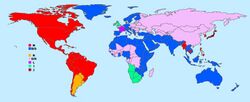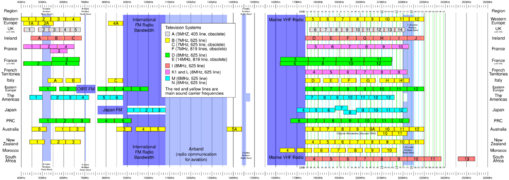CCIR System M
CCIR System M,[1][2][3] sometimes called 525–line, monochrome NTSC, NTSC-M, or CCIR-M,[4][5] is the analog broadcast television system approved by the FCC (upon recommendation by the National Television Systems Committee - NTSC)[6] for use in the United States since July 1, 1941,[7][8] replacing the 441-line TV system introduced in 1938.[8] System M comprises a total of 525 interlaced lines of video, of which 486 contain the image information, at 30 frames per second. Video is amplitude modulated and audio is frequency modulated, with a total bandwidth of 6 MHz for each channel, including a guard band.[9]
It was also adopted in the Americas and Caribbean; Myanmar, Philippines , South Korea , Taiwan and Japan (here with minor differences, informally referred to as System J). System M doesn't specify a color system, but NTSC (NTSC-M) was normally used, with some exceptions: NTSC-J in Japan, PAL-M in Brazil and SECAM-M in Cambodia, Laos and Vietnam (see Color standards section below).
The letter M designation was attributed by the ITU at the 1961 Stockholm meeting (see ITU identification scheme).[10]
Since 2015, System M is being replaced by digital broadcasting, in countries such as the Americas, Japan, South Korea, Taiwan and the Philippines.
Specifications
Some of the important specifications for System M are listed below:[11]
- Lines (total): 525
- Lines (visible): 486
- Frame rate: 29.97 Hz (NTSC color), 30 Hz (monochrome and PAL-M color)
- Channel bandwidth: 6 MHz
- Visual bandwidth: 4.2 MHz
- Sound offset: +4.5 MHz
- Vestigial sideband: 0.75 MHz
- Vision modulation: Negative
- Preemphasis: 75 μs
- Sound modulation: FM
- Color standards: NTSC-M, NTSC-J, PAL-M, SECAM-M, Clear-Vision, B-MAC
Color standards

NTSC-M and NTSC-J
Strictly speaking, System M does not designate how color is transmitted. However, in nearly every System M country NTSC is used for color television. This combination is called NTSC-M, but usually simply referred to as "NTSC", because of the relative lack of importance of black-and-white television. In NTSC-M and Japan's NTSC-J, the frame rate is offset slightly, becoming 30⁄1.001 frames per second, usually labeled as the rounded number 29.97.
PAL-M
The main exception to System M's being paired with NTSC color is Brazil, where PAL color is used instead, resulting in the PAL-M combination unique to that country. It is monochrome-compatible with other System M countries, but not compatible with other PAL countries, which use 625-line based systems.
SECAM-M
Between 1970 and 1991 a variation of the SECAM color system, known as SECAM-M, was used in Cambodia,[12] Laos, and Vietnam (Hanoi and other northern cities).
References
- ↑ Korea Electronics Association (1991). Journal of Korean Electronics. https://koreascience.kr/article/JAKO199173871470038.pdf.
- ↑ Alonso, Rodney Martínez; Pupo, Ernesto Fontes; Pan, Changyong (June 10, 2015). "Co-channel and adjacent channel interference in DTMB with 6MHz channel bandwidth". 2015 IEEE International Symposium on Broadband Multimedia Systems and Broadcasting. pp. 1–5. doi:10.1109/BMSB.2015.7177274. ISBN 978-1-4799-5865-8. https://ieeexplore.ieee.org/document/7177274.
- ↑ "C.C.I.R - DOCUMENTS OF THE Xlth PLENARY ASSEMBLY OSLO, 1966". https://search.itu.int/history/HistoryDigitalCollectionDocLibrary/4.277.43.en.1006.pdf.
- ↑ Pupo, Ernesto Fontes; Alvarez, Rufino Cabrera; García, Alejandro González; Hernández, Reinier Díaz (October 10, 2020). "Protection ratios and overload thresholds between 700 MHz FDD-LTE and analog/digital terrestrial television". 2020 IEEE International Symposium on Broadband Multimedia Systems and Broadcasting (BMSB). pp. 1–5. doi:10.1109/BMSB49480.2020.9379925. ISBN 978-1-7281-5784-9. https://ieeexplore.ieee.org/document/9379925.
- ↑ Odiaga, Martínez; Joussef, Hansel; Medina, Yarlequé; Augusto, Manuel (November 10, 2016). "Interference between UHF analog/digital television and LTE APT 700 MHz band: A field evaluation". 2016 8th IEEE Latin-American Conference on Communications (LATINCOM). pp. 1–5. doi:10.1109/LATINCOM.2016.7811615. ISBN 978-1-5090-5137-3. https://ieeexplore.ieee.org/document/7811615.
- ↑ Pursell, Carroll (April 30, 2008). A Companion to American Technology. John Wiley & Sons. ISBN 9780470695333. https://books.google.com/books?id=48YOVXgkq8QC&dq=525-line+standard+July+1%2C+1941.&pg=PA323.
- ↑ Herbert, Stephen (June 21, 2004). A History of Early Television. Taylor & Francis. ISBN 9780415326681. https://books.google.com/books?id=i_MndBVwJL8C&dq=525-line+standard+July+1%2C+1941.&pg=PA263.
- ↑ 8.0 8.1 Meadow, Charles T. (February 11, 2002). Making Connections: Communication through the Ages. Scarecrow Press. ISBN 9781461706915. https://books.google.com/books?id=iDEuQ_l__i0C&dq=525-line+standard+July+1%2C+1941.&pg=PA240.
- ↑ Rova, Andy (February 22, 2005). NTSC: Nice Technology, Super Color. https://www2.cs.sfu.ca/CourseCentral/820/mark/material/postscript/Presentations/arova_NTSC.ppt.
- ↑ Final acts of the European Broadcasting Conference in the VHF and UHF bands. Stockholm, 1961.
- ↑ "World Analogue Television Standards and Waveforms". 2007-05-15. http://www.pembers.freeserve.co.uk/World-TV-Standards/Transmission-Systems.html#CCIR.
- ↑ Broadband Data Book. Cisco. August 2019. pp. 31. https://www.cisco.com/c/dam/en/us/solutions/service-provider/industry/cable/pdfs/broadband-data-book.pdf.
See also
- NTSC — dominant color system used with System M, so much so that System M is often referred to as "NTSC". Much of the information in the NTSC article is actually about System M.
- Broadcast television systems — explains other types of television system standards
- Multichannel television sound — usual method for adding stereo to System M and System N audio carriers
- Pan-American television frequencies
 |




